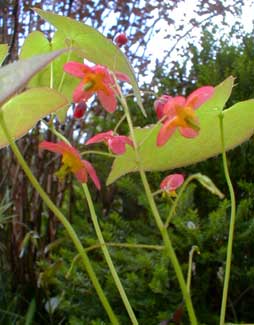
Warley Epimedium
"The clod, the tree, & starry flower,
Alone of all things have the power."
-Robert Louis Stevenson
(1850-1894)
(1850-1894)
We obtained Epimedium x warleyense without a cultivar name affixed to it, though it's almost certainly 'Orange Queen' ('Orangekonigin'). Warley's Epimedium's blossoms are even prettier than most epimedium flowers, rising in April (before new leaves) on wiry thin stems to ten inches or a foot, numerous with coppery orange, red, & yellow fairy-flowers.
Warley Epimedium is named after the Warley Place gardens of Ellen Wilmott (1858-1934) in Essex, whose garden & family names is commonly found echoed in many species & cultivar names (see for example Potentilla nepalensis 'Miss Wilmott'). Miss Wilmott was so fixated on her garden that she used up the family fortune on an extensive troop of hired gardeners, importation of plants from all around the world, & the funding of garden club activities including an expedition into China. By the time of her death she had bankrupted her estate.
By her obsession she gained a deserved reputation for garden expertise & for having developed one of England's most beautiful private gardens. She was one of her nation's leading arbiters of garden taste. But at the same time she was a notorious curmudgeon who would not share her plants with others, & when she did so, the recipients feared the plant was probably invasive. She was abusive to her hired gardeners & would throw tirades at the sight of a single weed. And when her fortune was gone she became something of a crazed hermit who shoplifted & booby-trapped her gardens for fear of plant thieves.
Her gardens are today cared for by the Essex Wildlife Trust, & may be visited by obtaining a day-pass from nearby Abbotts Hall Farm.
As for the Warley Epimedium, on Puget Sound its heart-shaped leaves are nearly evergreen but get scruffy before winter's end. Remaining leaves ought to be removed no later than March so that the first flowers will display by themselves, as otherwise the small bright April flowers can be obscured or entirely hidden by last year's worn-out leaves. By May with flowers still present they will have been joined by new leaves, which begin pale green with reddish margins, soon maturing to a mid-green. In autumn the leaves take on bronzy red hues. Epimediums are in general among the finest plants for dry shade, though regular watering may be required when first planted in order to get them well established. They prefer partial to full shade, & dry to moist &am well-draining soil, light & poor to rich & fertile. It naturalizes & slowly spreads by underground rhizomes. It can displace more delicate or smaller plants with its dense roots, but cohabits excellently with shrubs & deeply rooting perennials. This particular hybrid has a looser, airier foliage than many epimediums, so it does share its space with like-sized perennials with less reluctance than, say, 'Sulphureum,' which is much more densely foliaged during the main growing seasons. For propogation of further clumps, it can be lifted & divided once every few years in autumn. When autumn leaves are at their best color, some of them can be taken on their stems to be dried & used for dried floral arrangements.